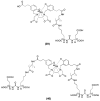Metal-Based PSMA Radioligands
- PMID: 28338640
- PMCID: PMC6154343
- DOI: 10.3390/molecules22040523
Metal-Based PSMA Radioligands
Abstract
Prostate cancer is one of the most common malignancies for which great progress has been made in identifying appropriate molecular targets that would enable efficient in vivo targeting for imaging and therapy. The type II integral membrane protein, prostate specific membrane antigen (PSMA) is overexpressed on prostate cancer cells in proportion to the stage and grade of the tumor progression, especially in androgen-independent, advanced and metastatic disease, rendering it a promising diagnostic and/or therapeutic target. From the perspective of nuclear medicine, PSMA-based radioligands may significantly impact the management of patients who suffer from prostate cancer. For that purpose, chelating-based PSMA-specific ligands have been labeled with various diagnostic and/or therapeutic radiometals for single-photon-emission tomography (SPECT), positron-emission-tomography (PET), radionuclide targeted therapy as well as intraoperative applications. This review focuses on the development and further applications of metal-based PSMA radioligands.
Keywords: PET; SPECT; intraoperative applications.; prostate specific membrane antigen (PSMA); radionuclide therapy.
Conflict of interest statement
The authors declare no conflict of interest.
Figures





















Similar articles
-
Prostate specific membrane antigen (PSMA) ligands for diagnosis and therapy of prostate cancer.Expert Rev Mol Diagn. 2016 Nov;16(11):1177-1188. doi: 10.1080/14737159.2016.1243057. Epub 2016 Oct 14. Expert Rev Mol Diagn. 2016. PMID: 27679869 Review.
-
Synthesis and evaluation of a novel near-infrared fluorescent probe based on succinimidyl-Cys-C(O)-Glu that targets prostate-specific membrane antigen for optical imaging.Bioorg Med Chem Lett. 2017 Nov 1;27(21):4876-4880. doi: 10.1016/j.bmcl.2017.09.037. Epub 2017 Sep 18. Bioorg Med Chem Lett. 2017. PMID: 28964633
-
PSMA Theranostics: Current Status and Future Directions.Mol Imaging. 2018 Jan-Dec;17:1536012118776068. doi: 10.1177/1536012118776068. Mol Imaging. 2018. PMID: 29873291 Free PMC article. Review.
-
Targeting PSMA by radioligands in non-prostate disease-current status and future perspectives.Eur J Nucl Med Mol Imaging. 2018 May;45(5):860-877. doi: 10.1007/s00259-017-3922-y. Epub 2018 Jan 15. Eur J Nucl Med Mol Imaging. 2018. PMID: 29335762 Review.
-
Toward the Discovery and Development of PSMA Targeted Inhibitors for Nuclear Medicine Applications.Curr Radiopharm. 2020;13(1):63-79. doi: 10.2174/1874471012666190729151540. Curr Radiopharm. 2020. PMID: 31362683 Free PMC article. Review.
Cited by
-
Therapeutic response and safety of radioligand therapy with 177Lu-PSMA-617 in metastatic castration-resistant prostate cancer patients.Med Oncol. 2024 Aug 13;41(9):226. doi: 10.1007/s12032-024-02466-7. Med Oncol. 2024. PMID: 39136842
-
Advances in PSMA theranostics.Transl Oncol. 2022 Aug;22:101450. doi: 10.1016/j.tranon.2022.101450. Epub 2022 May 18. Transl Oncol. 2022. PMID: 35597190 Free PMC article.
-
Innovative Peptide Therapeutics in the Pipeline: Transforming Cancer Detection and Treatment.Int J Mol Sci. 2025 Jul 16;26(14):6815. doi: 10.3390/ijms26146815. Int J Mol Sci. 2025. PMID: 40725089 Free PMC article. Review.
-
Radiopharmaceutical therapy in cancer: clinical advances and challenges.Nat Rev Drug Discov. 2020 Sep;19(9):589-608. doi: 10.1038/s41573-020-0073-9. Epub 2020 Jul 29. Nat Rev Drug Discov. 2020. PMID: 32728208 Free PMC article. Review.
-
Towards a 'clicked' PSMA targeting gene delivery bioconjugate-polyplex for prostate cancer.RSC Adv. 2024 Jul 29;14(33):23796-23801. doi: 10.1039/d4ra03640a. eCollection 2024 Jul 26. RSC Adv. 2024. PMID: 39077324 Free PMC article.
References
Publication types
MeSH terms
Substances
LinkOut - more resources
Full Text Sources
Other Literature Sources
Medical
Miscellaneous

